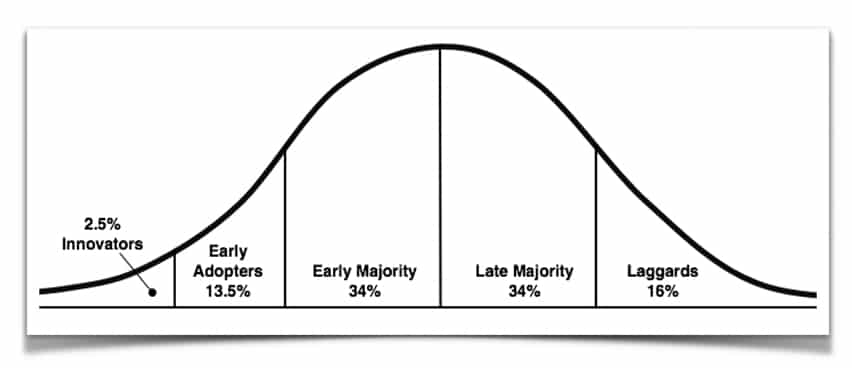Let’s explore the Diffusion of Innovations theory.
Developed by Everett Rogers, the Diffusion of Innovations theory explains how, why, and at what rate new ideas and technology spread, which is beneficial for understanding how to market new products or ideas. 1Everett Rogers. (2024, February 9). In Wikipedia. https://en.wikipedia.org/wiki/Everett_Rogers
Here we go:
Diffusion of Innovations
The diffusion of innovations theory, proposed by Everett Rogers in 1962, remains a framework for understanding how new ideas, technologies, products, or practices spread through societies over time. 2Rogers, E. M. (2003). Diffusion of Innovations (5th ed.). Free Press.

The diffusion of innovations theory outlines the process by which innovations are adopted by individuals and groups, emphasising the role of communication channels, social networks, and the characteristics of the innovation itself.
The diffusion of innovations theory offers insights into how new ideas and technologies influence societies. Understanding these dynamics can inform public relations strategies across diverse contexts.
“Diffusion research has helped understand new product adoption and diffusion, with network analysis and field experiments being promising tools in understanding the consumption of new products.”
Source: Journal of Consumer Research 3Rogers, E. (1976). New Product Adoption and Diffusion. Journal of Consumer Research, 2, 290 – 301. https://doi.org/10.1086/208642
Examples of Technological Adoptions
By examining real-life examples, we can better comprehend the principles of this theory and its applications in various fields:
Learn more: Diffusion of Innovations

THANKS FOR READING.
Need PR help? Hire me here.

What should you study next?
Spin Academy | Online PR Courses

Spin’s PR School: Free Psychology PR Course
Join this free Psychology PR Course to learn essential skills tailored for public relations professionals. Start now and amplify your impact on society today.
Psychology in Public Relations
Group Psychology
Learn more: All Free PR Courses
💡 Subscribe and get a free ebook on how to get better PR.

Annotations
| 1 | Everett Rogers. (2024, February 9). In Wikipedia. https://en.wikipedia.org/wiki/Everett_Rogers |
|---|---|
| 2 | Rogers, E. M. (2003). Diffusion of Innovations (5th ed.). Free Press. |
| 3 | Rogers, E. (1976). New Product Adoption and Diffusion. Journal of Consumer Research, 2, 290 – 301. https://doi.org/10.1086/208642 |


